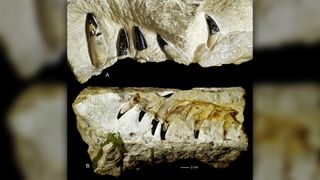Paleontologists in Poland lately unearthed the jaws and enamel of a monstrous pliosaur, an historic marine reptile with a chunk extra highly effective than that of Tyrannosaurus rex.
Pliosaurs, the largest of the Jurassic interval‘s ocean predators, lived round 150 million years in the past. Researchers discovered fossils of this huge carnivore in a cornfield within the Polish village of Krzyżanowice within the Holy Cross Mountains, together with a number of hundred bones of crocodile family, historic turtles and long-necked plesiosaurs — cousins of pliosaurs — in keeping with a brand new research.
Jurassic pliosaur fossils have been present in only some European international locations, and that is the primary time bones of the large marine predator have emerged in Poland, lead research writer Daniel Tyborowski, a paleontologist with the Polish Academy of Sciences’ Museum of the Earth in Warsaw, mentioned in a press release.
Associated: Picture Gallery: Historical Monsters of the Sea
A limestone block discovered on the web site in Poland held cone-shaped enamel and fragments of an higher and decrease jaw that the scientists recognized as belonging to a pliosaur, relationship between 145 million and 163 million years in the past. The most important tooth measured about three inches (68 millimeters) from crown to tip. One other giant, remoted tooth — additionally thought to belong to a pliosaur — measured about 2 inches (57 mm) in size, in keeping with the research.
Pliosaurs lived alongside dinosaurs (although not T. rex, which did not seem till round 70 million to 65 million years in the past, throughout the Cretaceous interval). “They measured over 10 meters [32 feet] in size and will weigh as much as a number of dozen tons,” Tyborowski mentioned within the assertion. “That they had highly effective, giant skulls and large jaws with giant, sharp enamel. Their limbs had been within the type of fins.” In contrast to plesiosaurs — which had lengthy, swish necks and small heads — pliosaurs had large heads supported by thick, highly effective neck muscular tissues that helped them crush the bones of enormous prey.
One recognized pliosaur species, Pliosaurus funkei, had a 7-foot-long (2 m) cranium and a chunk estimated to be about 4 occasions as highly effective as that of T. rex. These apex predators would have been on the high of the meals chain of their marine ecosystems, feasting on crocodilians, plesiosaurs, turtles and fish, the research authors reported. Six pliosaur species have been described up to now. Nevertheless, it’s not but recognized to which species the brand new fossils belong.
“We hope that the subsequent months and years will deliver even richer materials within the type of bones of enormous reptiles,” Tyborowski mentioned within the assertion.
Greater than 100 million years in the past, this mountainous area was an archipelago of islands surrounded by heat lagoons, however the number of Jurassic marine species on the mountain web site additionally instructed that this space was a “hub” the place the habitats of various teams of marine reptiles overlapped, the scientists reported.
Historical turtles and crocodile family are recognized from Mediterranean websites; they inhabited heat waters within the Tethys Ocean, an enormous sea that lay between two historic supercontinents — Gondawna within the south and Laurasia within the north — throughout the Mesozoic interval, 251 million to 65.5 million years in the past. However pliosaurs, plesiosaurs and ichthyosaurs (one other sort of marine reptile with lengthy, slender jaws) are extra generally present in cooler waters farther north. As a result of the positioning in Krzyżanowice holds fossils from each hotter and cooler environments, the researchers proposed that it represents a transitional zone that was as soon as a novel ocean ecosystem, in keeping with the research.
The findings had been revealed on-line Oct. 6 within the journal Proceedings of the Geologists’ Affiliation.
Initially revealed on Stay Science.
source https://cvrnewsdirect.com/remains-of-of-massive-jurassic-sea-monster-found-in-a-polish-cornfield/

No comments:
Post a Comment